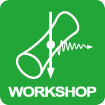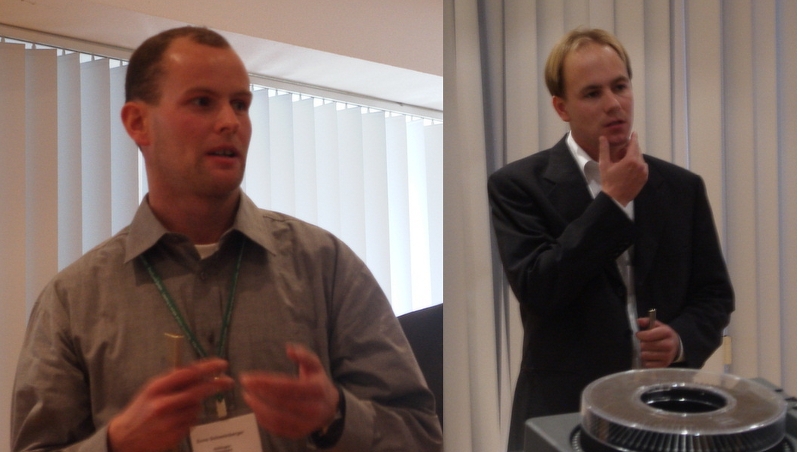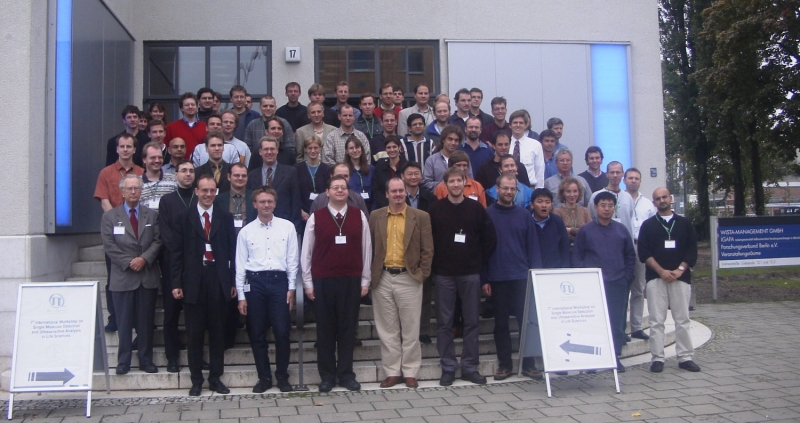Single Molecule Workshop
7th International Workshop on
"Single Molecule Spectroscopy and Ultrasensitive Analysis in the Life Sciences"
September 26 - 28, 2001 in Berlin, Germany

Summary
The recent years have seen an ever in-creasing interest in the detection and spec-troscopy of single molecules (SMD). Especially in genetics, molecular and cell biology, as well as in high-throughput screening and diagnostics, SMD under biologically native conditions became an important tool. With the event we hope to have encouraged the exchange of knowledge between the experts in SMD, interested scientists from other fields and potential users from industry.
The workshop was held only a few weeks after the terrible terrorist attacks in the US and was therefore somewhat overshadowed by these events. Nevertheless, it was one of the best workshops in this series and 75 researchers attended. One of the highlights this year was the participation of Watt Webb, Wenner-Gren Distinguished Lecturer and professor of physics at Cornell University. The workshop summary is best expressed by a citation from his closing remarks:
"This conference is different. I was very pleased to see all the young brains here and all the bright ideas. The area is bubbling and in the last years, we have seen an amazing development of new tools. They deliver what we need for new applications: accuracy, precision and quality.
What we need now is to tackle the applications in the life sciences that matter. There are lots of challenges in the biological and medical fields and they are only beginning to surface at single molecule conferences like this one.
Taking on these challenges needs careful attention to the subtleties of single molecule work.
Watch out when working with immobilized molecules. Will that enzyme still behave itself when stuck on a surface? My wish is that we should see more answers to such questions in the literature. You can get around these problems but you need to pay attention.
We need robust fluorophores. Quantum dots looked promising but they blink. Yet, there have been good ideas to overcome the blinking problem. Red Fluorescent Protein is good and very stable and a lot of work with RFP has been published. There are alternatives to fluorescence possible in second and third harmonic generation, and it should be a challenge to see if they work for imaging biological structures. There are important applications in investigations on membranes.
Two-photon excitation is another topic with more potential yet to be realized. New fluorophores are providing new tools, but in using fluorescence, a serious barrier is that nobody knows 'anything' about the photophysics of photobleaching. Background in biological materials is another big problem to be solved, but background can be useful! Look at the intrinsic fluorophores to use them in imaging biological function. To avoid it, consider that background fluorescence can also photobleach!
The bottom line is: Here is a group of bright young people with lots of good ideas. Tackle these important biological problems! Use your best methods. Many problems are inherently single molecule problems. For instance, body fluids can carry very 'sparse' aggregations involved in disease. Think about the plaques involved in Alzheimer's disease, prion diseases, and especially BSE (Bovine Spongiform Encephalopathy)! Consider clustering and aggregation in cytoplasms. Lots of challenges here! In your work, keep asking are we using the right tools? Do we know anything about it? Challenges in biological research! There are lots of elegant techniques. Use them!"
Invited speakers
- Jörg Enderlein (Regensburg, Germany)
- Katrin Kneipp (Berlin, Germany)
- Erwin Petermann (Amsterdam, Netherlands)
- Frans de Schryver (Leuven, Belgium)
- Gerhard Schütz (Linz, Austria)
- Watt W. Webb (Ithaca, USA)
Student award
 PicoQuant especially wants to encourage young scientists. Therefore a special prize of 1500 DM for the "Best Student Paper" was awarded by PicoQuant GmbH. Undergraduate and PhD students were invited to participate in this contest. It proved extremely difficult for the jury to nominate the winner, since there were so many good contributions. So in the end the price was split in two between Phillip Tinnefeld (Heidelberg) and Enno Schweinberger (Gottingen). For the best poster, the intention was to award a book prize (the brand new Wiley-VCH title 'Single Molecule Detectio in Solutions'). The posters were also so excellent that it was decided to give a copy of the book each to Elke Haustein (Göttingen) and Gerhard Blab (Leiden).
PicoQuant especially wants to encourage young scientists. Therefore a special prize of 1500 DM for the "Best Student Paper" was awarded by PicoQuant GmbH. Undergraduate and PhD students were invited to participate in this contest. It proved extremely difficult for the jury to nominate the winner, since there were so many good contributions. So in the end the price was split in two between Phillip Tinnefeld (Heidelberg) and Enno Schweinberger (Gottingen). For the best poster, the intention was to award a book prize (the brand new Wiley-VCH title 'Single Molecule Detectio in Solutions'). The posters were also so excellent that it was decided to give a copy of the book each to Elke Haustein (Göttingen) and Gerhard Blab (Leiden).
Archive
The workshop on "Single Molecule Spectroscopy and Ultra Sensitive Analysis in the Life Sciences" is an annual event since 1995. To get an impression of our Single Molecule Workshops have a look at the video below.
For a summary of each year's event, please select the year from the list below.
Thank you for registering for the Single Molecule Workshop!
An email with the supplied information has been sent to the provided address.
×

